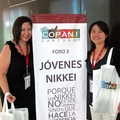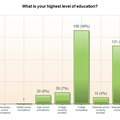Read part 1 >>
The results presented at the COPANI conference were from the five countries with the most respondents: the United States, Brazil, Peru, Mexico, and Chile. The majority of respondents from the United States were from Southern California. For the Latin American countries, responses were primarily from cities with large Nikkei communities: São Paulo, Brazil; Lima, Peru; Mexico City, Mexico; and Viña del Mar, Chile.
Here are some of the most popular results from the survey to our open-ended questions on culture, community, and identity:
Q. What is the most popular “Nikkei” food in your community?
Q. What Japanese term/word do you think Nikkei use the most in everyday conversation?
Q. What do you think is the most important Nikkei festival in your city?
Q. Name a “Nikkei” person who you think is the most well-known in the community
Q. What is the first word that comes to mind when you think of Japan?
Some key points: It is interesting to note that in all five countries, the most popular “Nikkei” food was sushi that was altered according to the local cuisine. In the case of the United States, spam musubi and California roll are popular; while in Mexico, Philadelphia cream cheese and avocado are common. In addition, the word or term arigato is used across all five countries, but in Brazil the word daijyobu is commonly used and in Peru, okane was in the top three responses.
Two benefits of this international survey were for each community to get a pulse on the various types of Nikkei festivals that are organized in other countries, and f to learn from each other the different ways of celebrating Japanese and Nikkei culture. For example, Festival do Japão is quite popular and unique to Brazil, while Semana Cultural is exceptional in Peru, and Obon and Nisei Week are distinct in the United States.
Lastly, the data from the survey reveals that Japanese values are deeply present in the Nikkei communities in North and South America as they are the first image that comes to mind when they think of Japan (i.e. values such as respect, discipline, order, and honesty).
One of the major themes of the conference and a question in our survey was the meaning of the term Nikkei. What does the word Nikkei actually signify? The term Nikkei can be interpreted in various ways depending on certain political, historical, and social contexts. According to the Encyclopedia of Japanese Descendants in the Americas: An Illustrated History of the Nikkei, (Kikumura-Yano, 2002) the definition of Nikkei refers to “people of Japanese descent and their descendants who have created unique communities within various national contexts throughout the Americas.”
However in our survey, the answers to the term Nikkei could be group under the following categories: 1) Blood, kinship, or descent; 2) Japanese cultural values or traditions; and 3) Self-Affiliation or self-definition. For example a Nikkei from the United States said, “Nikkei is someone of Japanese heritage. I am a sansei, that makes me a Nikkei.” A Nikkei in Brazil defined being Nikkei as having Japanese cultural values, “Someone who comes into contact with and admires the traditions and customs of the Japanese culture since childhood” (Alguém que têm contato e admira as tradições e costumes da cultura japonesa desde a infância).
For many Nikkei, the definition cannot be distinguished in concrete categories and witnessed how the fluidity of culture and identity influenced the socially constructed term. A Peruvian Nikkei explained the term Nikkei as, “Difficult, I think that being Nikkei no longer is just being a descendant of Japanese by blood, but also should involve the aspect of values, cultural aspects. We are a mixture of cultures but the Nikkei lives in both cultures; still trying to rescue the positive aspects of Japanese culture and proudly living it” (Difícil, creo que ser nikkei ya no es sólo ser descendiente de japonés por la sangre, sino que debe de involucrar también el aspecto de valores, aspectos culturales. Somos una mezcla de culturas pero el nikkei vive ambas culturas trata de rescatar aún los aspectos positivos de la cultura japonesa y vive orgulloso de ello).
Interestingly, in the United States, the specific term Japanese American was the second most popular definition of Nikkei and the words sansei and yonsei (i.e. I am a 4th generation, yonsei, Japanese American) were used more frequently than in Brazil, Peru, Mexico, or Chile. In addition, in Latin American countries, when describing the meaning of Nikkei, a family member was mentioned often (i.e. the grandson of Japanese immigrants; my parents are Japanese).
© 2011 Lindsey Sasaki









